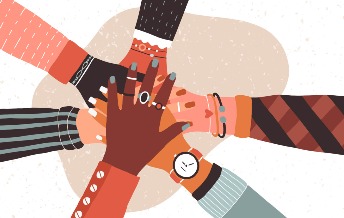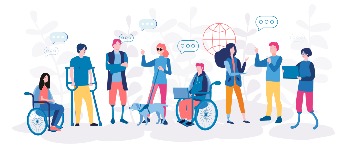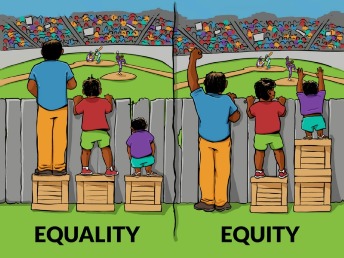Don’t let the pandemic drive us apart: Why Diversity, Equity and Inclusion are important

One would assume that in 2022 the concepts of diversity, equity, and inclusion (DEI) are no longer seen as new concepts. An increasing number of organisations and their leaders are starting to acknowledge the effectiveness of a more diverse work environment. It would be a bit ignorant if one continued to disregard the results of various studies that show the benefits of DEI, and thus forgo the competitive advantage that follows from more inclusive practices. I mean, who doesn't want an increase in innovation revenue of almost 20% (Boston Consulting Group)?! Furthermore, DEI has also become more important in science and academia. Universities are slowly taking action and establishing specifically dedicated DEI departments, or working groups such as ours, with the aim to enable a broader number of students and staff to succeed in their work and develop to their full potential. DEI has become the new figurehead for new opportunities.
So, while everyone finally agrees that DEI is the right thing to focus on, the terms are often used interchangeably. And it makes sense. The terms have been developed over time, show a lot of similarities and, funnily enough, until a few years ago, no one really cared about them. Considering this, how can we expect people to not only discuss these topics, but also to be experts on them? How can we demand everyone to be proficient, without them understanding the differences? How can we expect people to know and understand these terms when they were never taught what they meant or why they are important?
While there has been strong movements in the past regarding DEI which resulted in more people interacting with and discussing the concepts of DEI, the current pandemic is slowing down the progress we have made so far. It seems like there are more urgent problems to work on and businesses seem to forget about their previous endeavours. The consequences of “pausing” the establishment of more diverse and inclusive work practices might lead to bringing back and even reinforce old biases and discrimination at work. Thus, it is essential that we intervene now and ensure that DEI is not pushed into the waiting area. It should be all the more necessary right now to be inclusive to all people so that we as a society do not alienate minorities further. This blog article should therefore bring the three concepts closer to you and further help you understand their differences, their importance and the need to implement them all together to empower people and generate new opportunities.

Diversity
One of the most familiar concepts is probably diversity, not least because of the literal meaning of the word: “The condition of having or being composed of differing elements” (Merriam Webster), but because diversity in the workplace/classroom is relatively easy to understand, we hear about it all the time and the definition of it is easily applicable to real-life working scenarios. While it is easy to deduct that a diverse work team should therefore be made up of different kinds of people, the term different has changed and expanded over the years. Not long ago the discussion only circled around the representation of gender and ethnicity; by now, the concept also includes “race, colour, […], nationality, religion, socioeconomic status, veteran status, education, marital status, language, age, gender expression, […], gender identity, sexual orientation, mental or physical ability, genetic information, and learning styles” (Armstrong), to only name a few. In an ideal world, nothing regarding your identity should be in your way when it comes to applying for a job position or pursuing a career in academia, or in any other field.
When talking about diversity, we are looking at the quantitative representation of differences within a team. With the concept of diversity in mind, we can measure how many people we have of different (minority) groups, to ensure a broad mix of opinions and perspectives on the same topic. While a diverse team will likely engage in more discussions which might slow down the work progress in the beginning In the long run, it can aid in accessing new markets, improving
ways of communication and enable new opportunities that before, had not been considered.

Inclusion
In addition to the quantitative representation, the term inclusion adds the layer of qualitative experience to the discussion. It is not enough to solely bring a more diverse group of people to work together, if they cannot show their true authentic self (Ritu Bhasin). Inclusion describes the extent to which one can bring their true self into the room, and still has the same opportunities as anyone else, if not even generates new ones. That being said, in a truly inclusive work environment, one should be able to dress the way they want to, follow their cultural practices and talk about topics that are important to them (with good judgment, obviously). So, when one feels safe and does not experience the necessity to hide a certain aspect of their identity, when they are able to flourish and grow within their differences, inclusion has been achieved.

Equity
Of all three concepts, equity might be the most important; without it, diversity and inclusion would probably not work or would only show small improvements. At its core, equity aims to recognise the “historical legacies and current realities of discrimination […] that people of marginalised communities experience” (Ritu Bhasin). As many of us are starting from a place of privilege, it is not fair to give everyone the same resources and expect similar results. I don’t think I need to describe the famous equity-equality analogy of the three people trying to look over a fence again, but here is a picture of it to serve as an important reminder. So, if we already managed to understand diversity and inclusion, it should be an easy step to see that without equity, the other two concepts don't work. If we don’t see what marginalised communities had to go through to get to their current position, we will not be able to fully appreciate and support them in achieving future positions.
With equity, we start to look at power structures and systems of oppression. We start to understand the struggles of others and see what changes are necessary to improve everyone’s situation. Only if we can acquire this understanding, can we welcome a diverse group of people, and fully engage with each other. Only then, diversity, inclusion and equity can fully thrive and show their effectiveness in adding value, increasing productivity and enabling social equality.
What it all comes down to, is the need for a change of mindset. Welcoming everyone will not only lead to more opportunities and sustainable growth, it will also make society as a whole stronger. DEI is about empowering people and creating the feeling of belonging. If one feels respected and valued as an individual, while being supported and engaged by others, they will be able to perform at their best (Global Diversity Practice) .
We need to work on including the concepts of diversity, inclusion and equity, and by we, I mean each and every one of us. There are new challenges ahead for societies around the globe and DEI will be the basis to start conversations on power structures, privileges, racism, sexism, religion and much more. If you give people a cause and a voice, they will try to embrace it in every way they can, making sure that no one is left behind. Especially right now during a pandemic which is draining energy from all of us and seems to last forever, it is all the more important to work together and to see this crisis as a potential new chance to find prosperity for all.
Theresa Görs
Member of the Diversity, Equity and Inclusion (DEI) Working Group at Campus Fryslân

